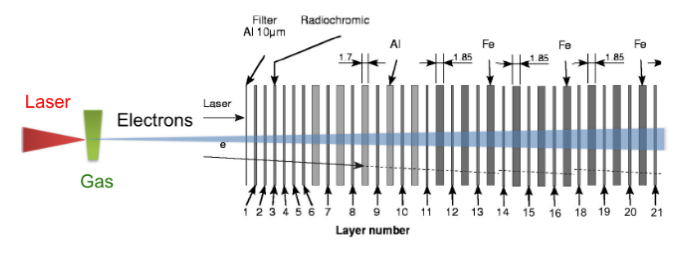Starting from 2008, with the demonstration of the first laser-plasma electron accelerator in Italy [1], the ILIL laboratory of CNR-INO in Pisa has started a research activity on the biomedical applications of electron beams, with particular reference to medical diagnosis and oncological radiotherapy. These studies exploit the ultrashort pulse duration and the high instantaneous dose rate from ionizing radiation generated by laser-plasma sources, the highest obtainable today from a compact radiation generator. The studies conducted so far, in collaboration with the CNR Institute of Clinical Physiology, the Unit of “Fisica Sanitaria” of the University Hospital in Pisa and other groups with strong expertise in the biomedical field, have enabled extensive calibration the source for pre-clinical uses and have confirmed its radiobiological effectiveness [2] with in vitro studies [3].

These studies motivated the upgrade of the ILIL laser system which, starting from 2018, is operational [4] for the production of high energy electron beams, known in the bio-medical field as Very High Energy Electrons (VHEE) [2]. Our recent measurements show [5] the accurate delivery, in depth, of radiation at high dose rate, using very high energy electron beams produced with the newly developed laser-plasma accelerator.

These results are contributing to pave the way for new and more effective radiotherapy protocols, also based on the so-called “FLASH effect” [6], which provides for the administration of the therapeutic dose in a single session and in a very short time and would lead to equivalent effects on the tumor and less damage to healthy tissues [7].
In this context, the Laboratory has conceived a pre-clinical research program aimed at demonstrating the possibility of administering therapeutic doses of VHEE in the FLASH modality. Achieving this goal is a prerequisite for the launch of a clinical trial to be completed by 2025.
The pre-clinical phase, already funded within the ELI-ITALY project (Extreme Light Infrastructure, ITALY), is currently underway [8] and is aimed to characterize the VHEE beam from a dosimetric point of view and to qualify the radiobiological effectiveness. At the same time, the design of a second generation VHEE source prototype is underway, capable of responding to the needs for the future administration of therapy in a hospital environment

FURTHER READING
[1]L. A. Gizzi, C. Benedetti, S. Betti, C. A. Cecchetti, A. Gamucci, A. Giuliettia, D. Giulietti, P. Koester, L. Labate, T. Levato, F. Michienzi, N. Pathak, A. Sgattoni, G. Turchetti and F. Vittori, Laser-Plasma Acceleration: First Experimental Results from the Plasmon-X Project, Proceedings of the 51st Workshop of the CHANNELING 2008 Conference on “Charged and Neutral Particles Channeling Phenomena”, World Scientific Publishing, The Science and Culture Series – Physics, pp. 495-501 — Published April 2010, ISBN:978-981-4307-00-0; https://doi.org/10.1142/9789814307017_0045
[2] Antonio Giulietti (Editor), Laser-Driven Particle Acceleration Towards Radiobiology and Medicine, Biological and Medical Physics, Biomedical Engineering, DOI 10.1007/978-3-319-31563-8_8 – ISBN: 978-3-319-31561-4 (Print) 978-3-319-31563-8 (Online); https://doi.org/10.1007/978-3-319-31563-8_8
[3] M.G. Andreassi, A Borghini, S. Pulignani, F. Baffigi, L. Fulgentini, P. Koester, M. Cresci, C. Vecoli, D. Lamia, G. Russo, D. Panetta, M.Tripodi, L. A. Gizzi, L. Labate, Radiobiological Effectiveness of Ultrashort Laser-Driven Electron Bunches: Micronucleus Frequency, Telomere Shortening and Cell Viability Radiation Research 186, 245-253 (2016); https:// https://doi.org/10.1667/RR14266.1
[4] “FLASH”, nuova frontiera contro i tumori, Comunicato Stampa CNR, 22/12/2021, https://www.cnr.it/it/comunicato-stampa/9907/flash-nuova-frontiera-contro-i-tumori
[5] Luca Labate, Daniele Palla, Daniele Panetta, Federico Avella, Federica Baffigi, Fernando Brandi, Fabio Di Martino, Lorenzo Fulgentini, Antonio Giulietti, Petra Köster, Davide Terzani, Paolo Tomassini, Claudio Traino, Leonida A Gizzi, Toward an effective use of laser-driven very high energy electrons for radiotherapy: Feasibility assessment of multi-field and intensity modulation irradiation schemes, Scientific Reports 10, 17307 (2020); https://doi.org/10.1038/s41598-020-74256-w
[6] V. Favaudon et al., Science Translational Medicine, 6 245 (2014)
https://doi.org/10.1126/scitranslmed.3008973
[7] Leonida A. Gizzi, Un balzo tecnologico per la nuova radioterapia, su Sapere Scienza, http://www.saperescienza.it/rubriche/fisica-e-tecnologia/un-balzo-tecnologico-per-la-nuova-radioterapia
[8] Leonida A. Gizzi, Luca Labate, Federica Baffigi, Fernando Brandi, Giancarlo Bussolino,Lorenzo Fulgentini, Petra Köster, and Daniele Palla, Overview and specifications of laser and target areas at theIntense Laser Irradiation Laboratory, High Power Laser Sci. and Eng. 9, e10 (2021); https://doi.org/10.1017/hpl.2020.47
